



Study with the several resources on Docsity

Earn points by helping other students or get them with a premium plan


Prepare for your exams
Study with the several resources on Docsity

Earn points to download
Earn points by helping other students or get them with a premium plan
Community
Ask the community for help and clear up your study doubts
Discover the best universities in your country according to Docsity users
Free resources
Download our free guides on studying techniques, anxiety management strategies, and thesis advice from Docsity tutors
Material Type: Quiz; Class: ECONOMICS OF HEALTH CARE; Subject: Economics; University: Drake University; Term: Spring 2005;
Typology: Quizzes
1 / 3

This page cannot be seen from the preview
Don't miss anything!


Regulation & Antitrust Policy (Econ 198) Signature: Drake University, Spring 2005 William M. Boal Printed name:
INSTRUCTIONS: This exam is closed-book, closed-notes. Simple calculators are permitted, but graphing calculators or calculators with alphabetical keyboards are NOT permitted. Numerical answers, if rounded, must be correct to at least 3 significant digits. Point values for each question are noted in brackets. Maximum total points are 100. I. Multiple choice: Circle the one best answer to each question. [4 pts each: 32 pts total] (1) If an industry is a monopoly, its Hirschman- Herfindahl Index (HHI) is a. zero. b. 20. c. 100. d. 10,000. (2) If an industry consists of 20 firms of equal size, its Hirschman-Herfindahl Index (HHI) is a. 5. b. 25. c. 400. d. 500. (3) Suppose an industry consists of two firms: #1 and #2. Consider two possible distributions of market shares: A. Each firm has 50% market share. B. Firm #1 has 70% market share and Firm # has 30% market share. Which distribution is more concentrated according to the Hirschman-Herfindahl Index (HHI)? a. Distribution A. b. Distribution B. c. The two distributions are equally concentrated because the number of firms is the same (2). d. Cannot be determined from the information given. (4) Suppose an industry behaves like a Cournot oligopoly. If the elasticity of demand is -2 and the Hirschman-Herfindahl Index (HHI) is 1000, then the average Lerner index (or "price-cost margin") for this industry is a. 0.02. b. 0.05. c. 0.10. d. 0.50. (5) Suppose an industry is a Cournot oligopoly but entry is possible after firms pay a fixed, sunk entry cost. In equilibrium, the number of firms is a. positively related to the entry cost. b. negatively related to the entry cost. c. unrelated to the entry cost. d. Cannot be determined from the information given. (6) A contestable market is a. perfectly competitive. b. an oligopoly with a large number of firms. c. an oligopoly with a small number of firms. d. a natural monopoly with entry costs that are not sunk. (7) Suppose a dominant firm shares a market with a competitive fringe of smaller firms. If the dominant firm cuts price, a. total market quantity increases and fringe quantity supplied increases. b. total market quantity increases and fringe quantity supplied decreases. c. total market quantity decreases and fringe quantity supplied increases. d. total market quantity decreases and fringe quantity supplied decreases. (8) Suppose a dominant firm shares a market with a competitive fringe of smaller firms. Everything else equal, the more elastic is the competitive fringe's supply curve, the a. more market power the dominant firm has. b. less market power the dominant firm has. c. The elasticity of fringe supply has no effect on the market power of the dominant firm. d. Cannot be determined from the information given.
Regulation & Antitrust Policy (Econ 198) Quiz # Drake University, Spring 2005 Page 2 of 3 II. Problems: Insert your answer to each question below in the box provided. Feel free to use the margins for scratch workonly the answers in the boxes will be graded. Work carefullypartial credit is not normally given for questions in this section. (1) [Imperfect competition: 44 pts] Monsta Corporation is the dominant firm in its industry.. The following diagram shows total market demand, marginal cost for Monsta Corporation, and the supply curve of the follower firms or "competitive fringe." Assume the "competitive fringe" firms take price as given.
b. At what price would the quantity supplied by the competitive fringe be sufficient to supply the entire quantity demanded by the market?
c. Suppose the price were $3 for some reason. How much output would be left to the dominant firm to supply? d. Suppose the price were $5 for some reason. How much output would be left to the dominant firm to supply? e. Using a straightedge , draw the residual demand curve available to the dominant firm. Label it. f. Using a straightedge , draw the residual marginal revenue curve available to the dominant firm. Label it. g. What quantity will the dominant firm seek to supply to maximize its profit?
i. Compute the dominant firm's Lerner index (or "price-cost margin") [Hint: By definition, the Lerner index = (P-MC)/P. j. What quantity will the competitive fringe firms supply as a result? k. What would be the socially-efficient level of output, where all demanders willing to pay the marginal cost of the dominant firm are served?